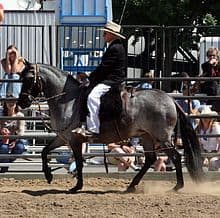Type the name of the breed you're looking for below
[wpdreams_ajaxsearchlite] Don't see the breed your're looking for? Click here and let us know!
Peruvian Paso
| Country Of Origin | Peru |
| History and Background | Smooth-gaited horses, generally known as Palfreys, existed in the Middle Ages, and the Jennet in particular was noted for its ambling gaits. Peruvian Pasos trace their ancestry to these ambling Jennets; as well as to the Barb, which contributed strength and stamina; and to the Andalusian which added style, conformation and action. Horses arrived in South America during the Spanish Conquest, beginning with the arrival of Pizarro in 1531. Foundation bloodstock came from Spain, Jamaica, Panama and other areas of Central America. Importations increased after 1542, when the Spanish created the Viceroyalty of New Castilla. This later became the Viceroyalty of Peru, an important center of Spain's New World colonies in the eighteenth century. Once in Peru, they were used primarily for transportation and breeding stock. In the north of Peru, the vast size of sugar and cotton plantations meant that overseers needed to travel long distances, often taking days to cross the plantation. In the south of Peru, the arid deserts that separated settlements required sturdy, strong horses. In both cases, smooth-gaited horses with good endurance were required. On the other hand, Peru did not develop a livestock-based economy, and thus did not need to breed for the speed or agility characteristic of stock horses. Over time, Peruvian breeders kept the bloodlines clean and selectively bred primarily for gait, conformation, and temperament. They wanted strong, hardy animals that were comfortable to ride and easy to control. Over four centuries, their dedication to breeding only the best gaited bloodstock resulted in the modern Peruvian Paso. A decline in the use of the Peruvian Paso horse was seen in the southern part of Peru in the early 1900s, following the building of major highways that allowed motor travel to replace the use of the horse. Many of the major breeders in the area gave their best horses away to peasants living in the nearby quebradas (valleys). It was in one of these quebradas that breeder Gustavo de la Borda found the horse that was to become the most important modern sire in the breed, Sol de Oro (Viejo). The Peruvian Paso continued to flourish in the northern regions because it was still needed for transportation on the haciendas. This changed with the harsh Agrarian Reforms instituted by the government of Juan Velasco Alvarado in the late 1960s that had a devastating effect on the Peruvian Paso horse within Peru. Major breeding operations were broken up and breeding stock was lost. Because interest in the Peruvian Paso horse was growing in the United States and Central America at the same time, many of the finest Peruvian Paso horses were exported, leading to a period where it appeared the Peruvian Paso horse would fade in its homeland. The past thirty years have seen a resurgence in the Peruvian Paso horse's fortune in Peru. The annual National Show in Lima is a major event in Peruvian cultural life. The Peruvian Paso has been declared a Patrimonio Cultural (Cultural Heritage) of Peru in an attempt to shore up the breed within the country. There are now laws in place that restrict the export of national champion horses. Peruvian Paso horses are noted internationally for their good temperament and comfortable ride. As of 2003, there are approximately 25,000 horses worldwide, used for pleasure riding, trail, horse shows, parades, and endurance riding. |
| Use Today | Show horse, parade horse, endurance horse |
| Height | 14 - 15 hands (56 - 60 inches) |
| Colour | All colours |
| Characteristics | The Peruvian horse has a deep chest, heavy neck and body with substance without any trace of being hound gutted in the flank area. A low set, quiet tail, clamped tightly between the buttocks is a vital quality. Stallions have a broader chest and larger neck than mares. |
| Personality and Temperament | Amiable and moldable the Paso makes a well-rounded mount. |



